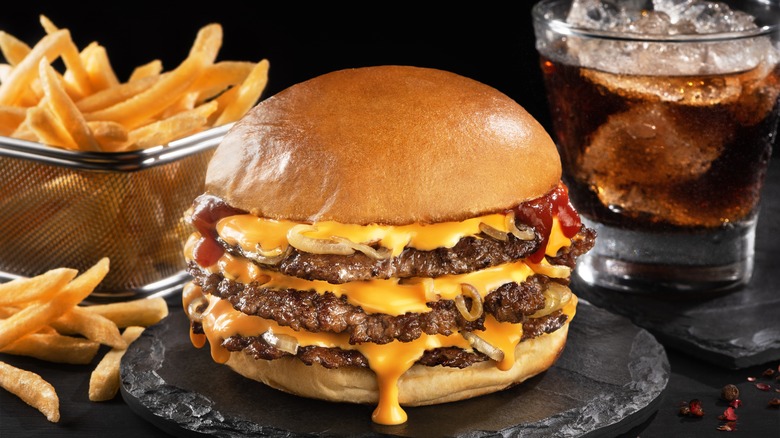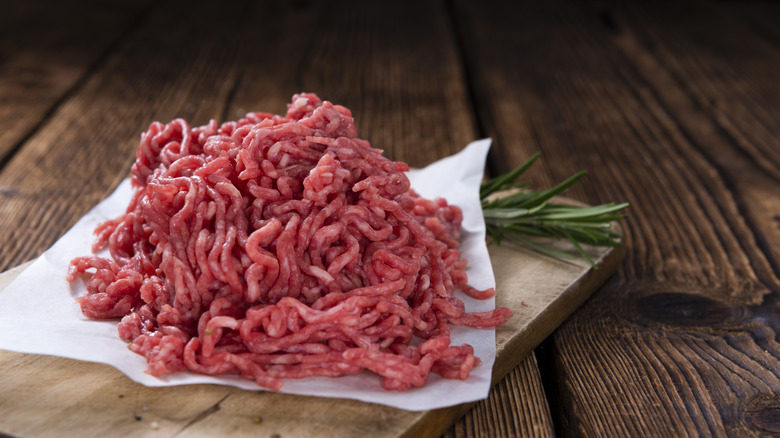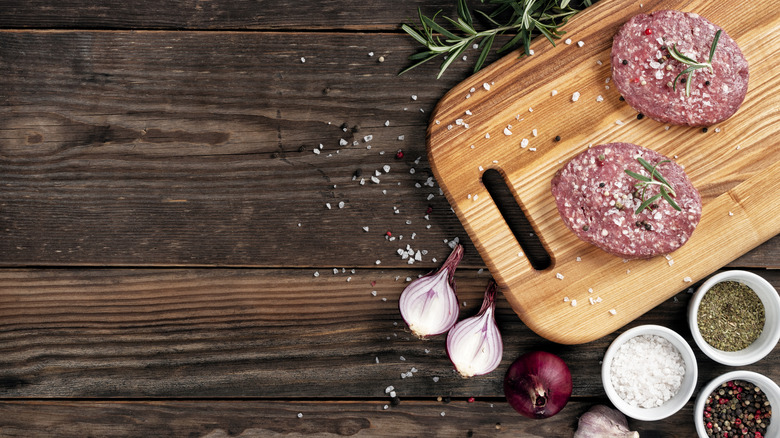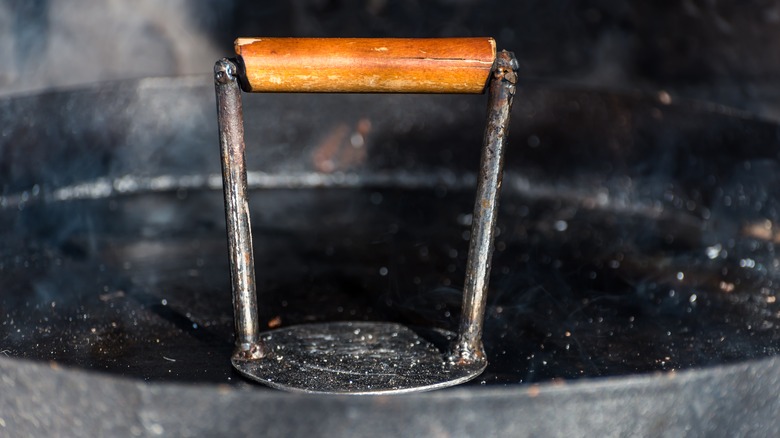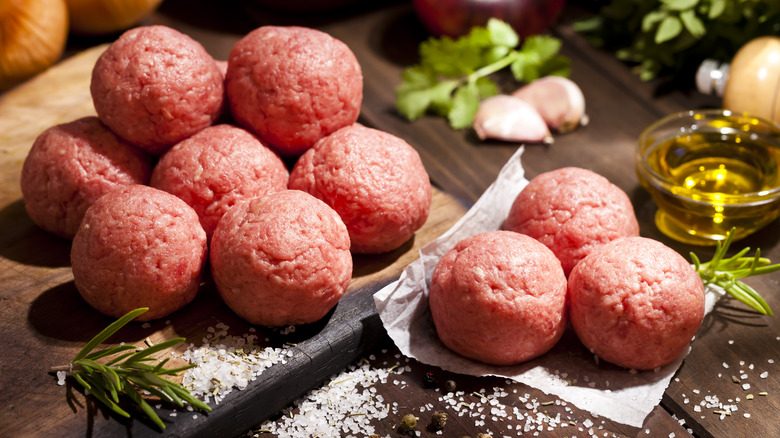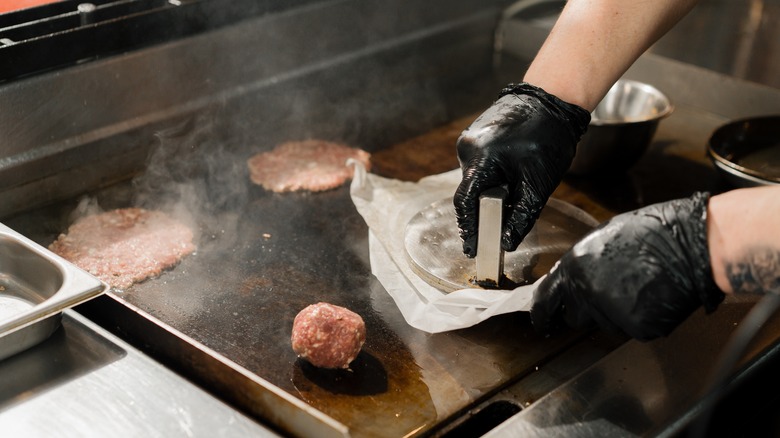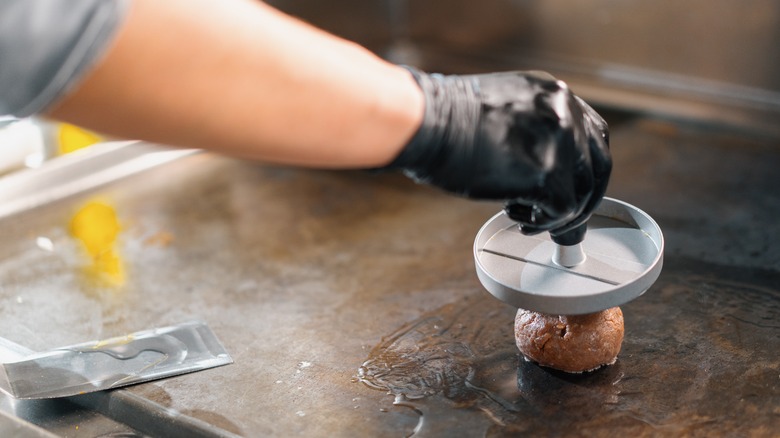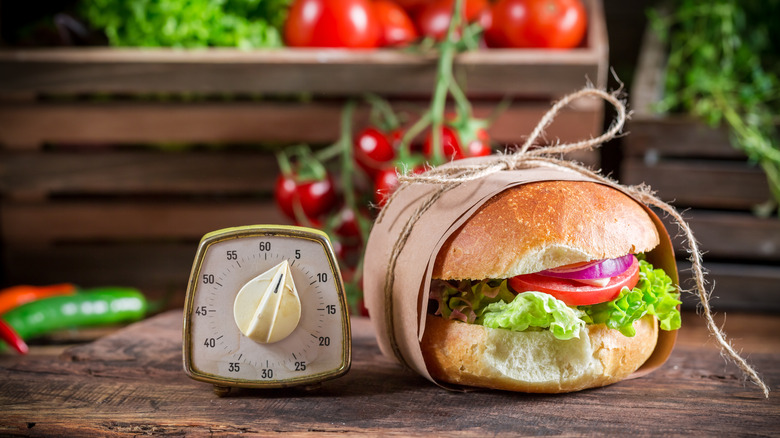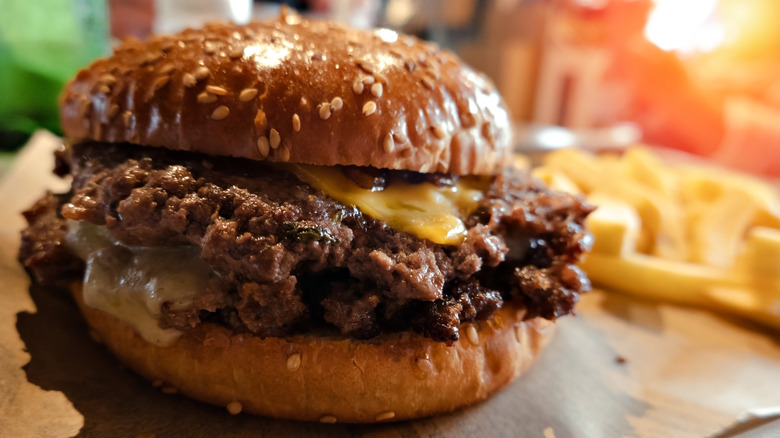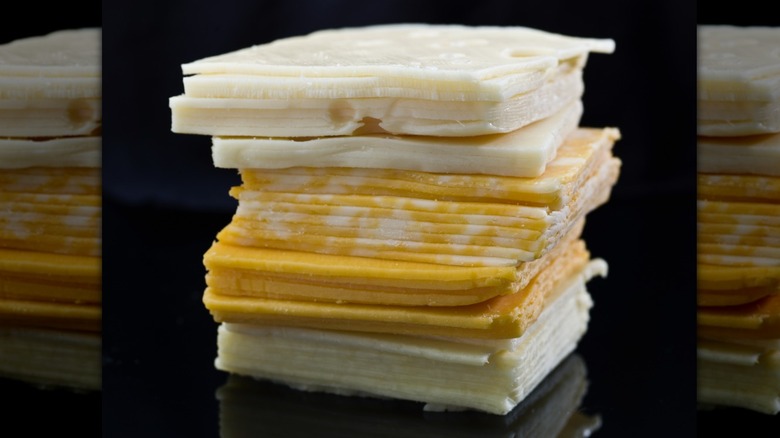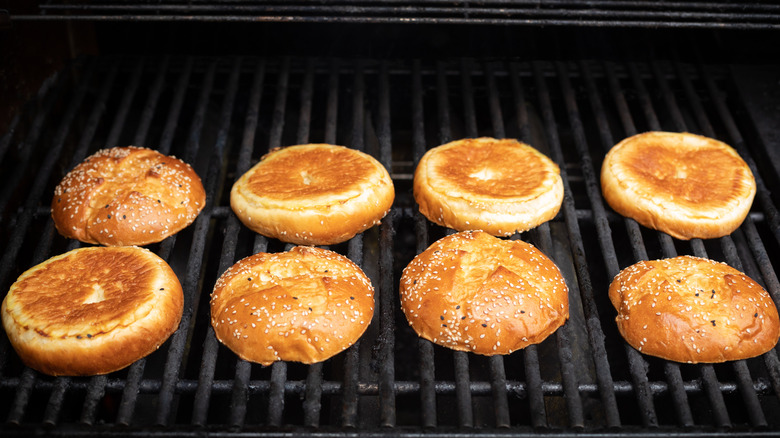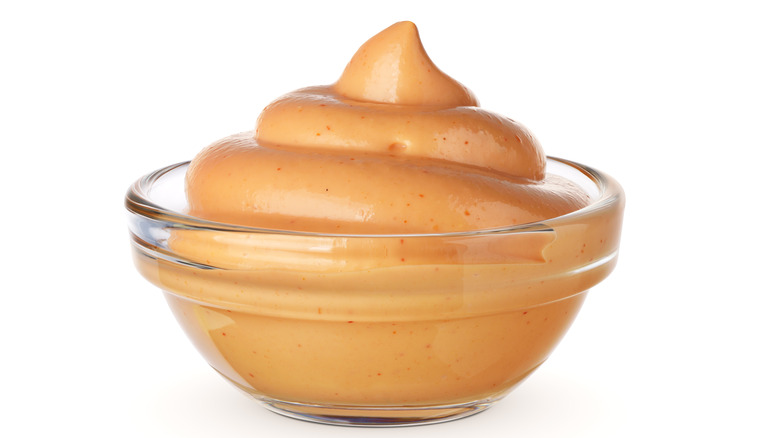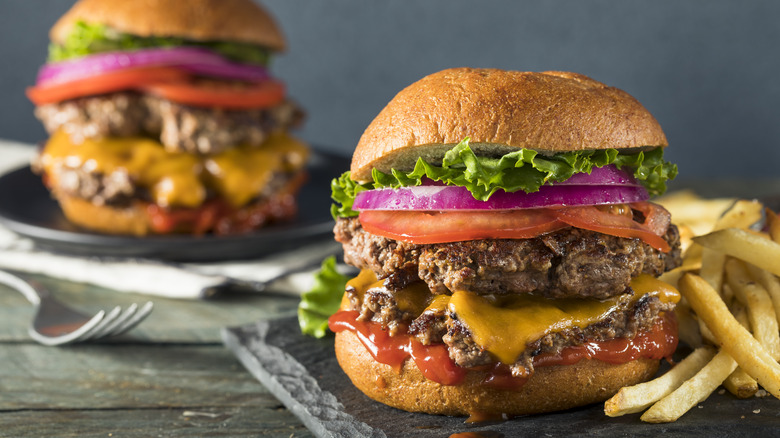12 Tips For Making The Ultimate Smash Burger
If your favorite part of a burger is the crust, flavorful and dripping with salty juice when you bite into it, you're not alone. For years burger enthusiasts had no idea what they were missing. Now, popular chains like In-N-Out, Shake Shack, and Five Guys perfected the art of this super thin patty with crave-able toppings.
But, there is a method to the madness, and not everybody does it right. Just because it's thin doesn't mean it's a smash burger. White Castle burgers are thin, but the technique differs, resulting in a steamed patty instead of a seared one. That cooking technique alone turns a so-so hunk of ground meat into something spectacular.
What does this mean for home cooks? It means that attention to detail makes all the difference. Everything from the type of meat to the pan to the final toppings matters. Even the best ingredients won't cover poor cooking techniques, and the best cooking technique in the world won't save a dry patty. It is possible, however, to make delectable smash burgers at home. And it all starts with quality ingredients, attention to detail, and the proper technique.
12. Choose the best meat
Smashed, stacked, in sliders or traditional style, the best burgers begin with the best meat for burgers. Choosing the best ground meat is important when it comes to a smash burger because of how thin the patty is: If your meat is too lean, it will dry out; too fatty, and you're basically poaching the meat in its own fat. The magic ratio? An 80/20 percentage of meat to fat. Any lower fat content is likely to dry out, but any higher and the fat releases too quickly, ending up with a drippy smash burger that's still dry inside.
Another thing to consider is the type of meat you use. It is possible to swap beef with ground turkey for a leaner burger, but if you're going with beef, pay attention to the cut. Ground chuck is generally your best bet for ease of preparation, coming in at the correct ratio. However, consider grinding a personalized blend if you'd like to get a bit chef-y. It doesn't matter what meat you use as long as your final ratio hits those magic numbers.
Don't be nervous to try different meats in your smash burger. Bison is great, as are trimmings from last night's beef brisket or any other wild game. Bacon also boosts both the fat content and the flavor. Don't have a meat grinder? Ask your local butcher to grind you a blend with the right amount of fat.
11. Season properly
With smash burgers, seasoning is not just a matter of how much — the more critical question is when. You may understand the idea of creating layers of seasoning, and adding a little bit of salt and pepper at each stage of the cooking process, but this technique breaks down when it comes to smash burgers. Salt begins to change the texture of meat immediately. Adding salt when forming patties can cause them to become tough and dry.
For best results, add a generous amount of salt and pepper (about ¾ teaspoon of each per pound of meat) after patties are formed, right when they hit the pan. You can add other seasonings in before you form the patties, though. Paprika or smoked chili powder is delicious, as are garlic and onion powder.
If you want most of the flavor to come from the meat but like the idea of some rich undertones, take Tyler Florence's crispy burger tip. He juliennes or chops onions and throws them in the pan first, giving them a minute to caramelize before smashing a burger on top. This is a White Castle-style move, but the smashing helps keep edges crispy and infuses every bite with the sweetness of cooked onion.
10. Use the correct pan
You've chosen the perfect blend of meat and seasoned it correctly. Don't ruin all of your good work by busting out the cheap nonstick pan you've been using for years. The beauty of a smash burger is in the browning. The Maillard reaction occurs when heat changes the structure of the protein. Proteins break apart and form different compounds repeatedly throughout the cooking process so that the crust takes on a toasty smell and a deeply browned color when the burger is done. It's not the same thing as caramelizing, but the effect on your salivary glands is similar.
The Maillard reaction doesn't start until 300 degrees Fahrenheit (and really gets going at temps above that). The only way to get the true crispy sear of a smash burger is to cook it in a pan that can reach and hold a screaming hot temperature evenly. Cooking smash burger at high heat is required, but at these temperatures, nonstick coatings can begin to evaporate, sending chemicals into the air and your food.
The best pan for the job is a cast iron skillet. Cast iron heats evenly, with no cold spots, and can handle a long preheat. Carbon steel is another good option, though. It is lighter than cast iron and, with proper use and care, can eventually become nonstick without the harmful chemical coating. A high-quality stainless steel pan will also work.
9. Portion carefully
The next consideration for the best smash burger is portioning the meat. Size matters here. Many chefs go for a 4-ounce burger, which fits perfectly inside most burger buns when smashed. However, a slightly smaller portion means that your burger will cook faster, with more crunchy bits on the outside. And if you like to double up your burger sandwich, portion meat into 2 or 3 ounces for a more manageable meal.
Now that you know how big your balls of beef will be, it's time to consider how you handle your meat. Some cooks believe the meat balls should be packed tightly, while others loosely pack them. It might seem that because you are weighing the meat, how you portion it and shape it doesn't matter. But don't be fooled.
One of Pat LaFrieda's secrets to a great smash burger is to pack the meat into loose balls to create more surface area when the burger is smashed. This creates pockets inside the patty and opportunities for more browning. Because your meat should be very cold (not room temperature), this loose meat ball may be harder to smash, but the effort is worth the reward: a juicy patty with more of the browned edges that make smash burgers so delectable.
Portion using a kitchen scale, then roll into loosely packed balls. Keep them in the fridge while you assemble your other tools and heat your pan.
8. Use parchment paper
Parchment paper is a hardworking culinary tool that makes it easy to lift fudgy brownies from the pan and separate sticky confections when storing leftovers. But it's no unitasker. Parchment paper has a place in the world of savory cooking — it's a special secret weapon for a cleaner smash. Parchment paper between the meat and the smashing tool has two purposes: Parchment paper is nonstick, which means that it won't stick to your smashed patty. Without parchment paper, your patty could stick to your cooking tools, potentially tearing it apart and removing meat from the heat before it has time to sear. Your meat cooks more evenly, too.
Parchment paper makes cleaner smash burgers, and this means less messy cleanup afterward. And although it's great to reuse kitchen materials as much as possible, parchment paper is disposable. Look for unbleached and natural versions to soften the environmental impact of disposing of it.
7. Master the smash
When to smash? How often to smash? How much is too much? What's not enough? First, smash the burger within 30 seconds of hitting the pan. This keeps more juices inside the meat and sets more of the meat's surface area against the high heat of the pan (which will cool down slightly when the cold meat hits it). Because you have loosely shaped the meat ball, not seasoned it until after the smash, and smashed it within 30 seconds, the protein structure that gets tighter as it heats up does not release the juice (rendered fat, in this case). The rendered fat stays trapped inside the strands of protein as it cooks.
So, form the ball, place it in the pan, season it with salt and pepper, and smash. You can use a stiff metal spatula, a purpose-built burger press, a small saucepan, or even a can of beans to smash. Some people think a spatula is the tool of last resort. If the smash is not applied evenly, you can end up with a sloped smash burger that cooks unevenly. When a metal spatula is all you've got, take care to smash the whole burger with equal force.
6. Don't smash too often
So far, you might feel pretty pleased with yourself. But on your first bite, it's like eating a mouthful of flavored sand. What went wrong? Admit it. You got impatient and figured that if one smash was good, two might be great, right? Wrong.
If you smash your burger after about the one-minute mark, all of the juices that have been trapped within the tightening protein structure of the meat will be dispersed outside of the burger, never to return. This dries your burger out before you even have a chance to flip it. The moral of the story? To prevent dry smash burgers, Smash once, cook for about 90 more seconds on the first side, then flip.
When you flip, use that metal spatula to get under the burger to grab all of the crispy brown bits of flavor — you want your smash burger to stick to the pan. Add your cheese right after the flip, and cook the burger until the cheese begins to droop. If you go past the two-minute mark on the second side, chances are good that even if you only smashed once your burger will begin to dry out.
5. Make it a double
Everyone knows why smash burgers are so delicious. There's more surface area that hits the heat and more of a reaction that causes browning and toasty, delicious flavors to issue forth from every nook and cranny of the burger. But, sometimes, you want a burger big enough to sink your teeth into, one that requires you to unhinge your jaw like a python to get a bite.
This doesn't mean you have to give up a smash burger. In-N-Out popularized the double-double style with double the smashed patties and double the toppings (or the triple-triple with more of the same), and you can have that at home, too.
It doesn't take much extra time, but if you're worried about seasoning and smashing correctly, you can smash ahead and freeze burgers. Wrap tightly in plastic wrap and thaw in the fridge. When it's time for dinner, heat your pan and get your salt and pepper ready. Season each pre-smashed burger as it hits the pan, and cook as usual.
4. Choose the best cheese
Save your gourmet cheeses for a fancy charcuterie board. The surveys went out, and the verdict is in. There's really one standout cheese that melts the best on a smash burger, and that cheese is American. Those individually wrapped, slightly shiny squares of yellow are the second most popular cheese in the U.S., and it's number one in smash burgers. Why?
American cheese is a thinner slice of cheese, which generally melts faster. But the ingredients list helps that along, too. Filled with ingredients that liquidate quickly over lower temperatures, American cheese gets gooey fast — perfect for the short cooking times of a smash burger.
This doesn't mean that other cheese has no place in the realm of the smash burger — some other quick-melting and creamy cheeses work well when sliced thinly (or shredded). Try colby, Monterey Jack, and gouda if you cannot go with American.
3. Pick the best bun
Unless you've gone Paleo, a smash burger is not complete unless it is resting on a bun. But choose wisely here, too. A huge bun will swallow the hard-won flavor of your burger (and most of the juices). A too-small bun won't be able to contain the toppings and special sauces that finish off the best smash burgers.
You're looking for a Goldilocks-style bun that's just right, and the just-right bun for a smash burger is a brioche bun. This French creation has a soft interior, perfect for catching all of the juices and melting cheese, and a slightly chewy exterior that is toothsome, with a satisfying chewiness that plays perfectly off the tender interior.
The brioche burger bun is best toasted. Toasting activates the Maillard reaction in the bread, intensifying the flavor of both burger and bun before you even start to consider your toppings and sauces.
2. Choose a great sauce
An epic smash burger does start with perfectly prepared meat, but the secret might literally be in the sauce. Restaurant chains and mom-and-pop shops specializing in smash burgers all have their own version, but most traditional sauces include at least sweet relish, ketchup, mayo, and vinegar.
The perfect sauce for a smash burger needs to be balanced. It cannot be all rich fat, added sugars, or tart vinegar. Start with a ratio of 2:1, mayonnaise to ketchup, then customize it as you see fit. Add vinegar if you like a little tang (red wine or cider are classic). Prefer more sweetness? Add a sweet pickle relish.
For a savory version that closely mirrors Shake Shack's sauce, consider skipping the sweet pickle relish and swapping in dill pickle brine. Although their actual recipe is a secret, dill pickle brine is definitely present, followed by the burn of cayenne pepper and the tang of Dijon mustard. But, don't think too hard about it. Burger purists might skip a fancy sauce altogether and go with the classic ketchup and mustard.
1. Assemble the smash burger
Assembling your smash burger is about striking the perfect balance between highlighting the delicious beefy flavor you crave and the sauces and toppings that offer a delicate counterpoint to the entire experience. While everyone's Burger should be assembled to their own taste, there is a danger of losing the taste of beef under too much or too many toppings.
A properly assembled smash burger will include some of each element in every bite. Start by placing your toasted bun on the plate. Spread the top bun with sauce and set it aside (some people prefer their sauce on the bottom). If you enjoy bread and butter pickles on your burgers, stick them into the sauce on the bun. Add your smash burger (or two if you are doubling up) to the bottom bun, then continue with toppings. Some people enjoy tomatoes, raw onions, and lettuce, but it's up to you.
Once you have added your toppings, cap it off with the top bun. You may need to secure it with a steak knife driven top to bottom. Go traditional and serve with fries, or skip the added carbs and nestle the burger up to a side salad with crunchy romaine lettuce.
